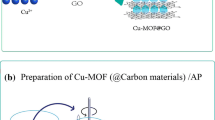Abstract
The nano-sized metal oxides (MOs) as combustion catalysts have been widely employed in solid rocket propellants, but the functionality of these materials is greatly restricted owing to their agglomeration. The catalytic activity of MOs on nanoscale was found to be significantly improved by the incorporation of MOs with carbon nanomaterials, which normally act as carriers allowing for well-distribution of MOs. In this paper, the CuO and Fe2O3 nanoparticles were produced by hydrothermal method and the CuO@C and Fe2O3@C nanocomposites with a uniform structure have been fabricated by an in-situ growth of corresponding MOs on the porous activated carbon (pAC). The morphology of the prepared MOs nanoparticles and resultant pAC carried ones were characterized using scanning electron microscope. It has been shown that the CuO and Fe2O3 nanoparticles are tightly adhered and dispersed on the surface of pAC. Their catalytic effects on the thermal decomposition of hexogen (RDX) were analyzed using thermal analysis techniques. Results indicate that the thermal decomposition of RDX was considerably promoted in the presence of these catalysts, where the CuO@C and Fe2O3@C were found to be capable of lowering the Tp for RDX by 14.8 °C and 12.4 °C, respectively. In addition, the decomposition kinetics of RDX in the presence of these catalysts have been evaluated with the DTG and DSC experimental data, and results show that the CuO@C and Fe2O3@C were able to reduce the Ea of RDX decomposition by 39.8 kJ mol−1 and 50.7 kJ mol−1, which is suggestive of an enhanced decomposition process for RDX by addition of carbon-loaded catalysts. The TG-FTIR analysis indicates that, in the presence of CuO@C and Fe2O3@C, the gaseous products are dominated by N2O in RDX decomposition.










Similar content being viewed by others
References
Wang YL, Wei ZX, Li K. Progress on combustion catalysts of solid propellant. Chin J Energ Mater. 2015;23(1):89–98. https://doi.org/10.11943/j.issn.1006-9941.2015.01.018.
Ivanov YF, Osmonoliev MN, Sedoi VS, Arkhipov VA, Bondarchuk SS. Productions of ultra-fine powders and their use in high energetic compositions. Propellants Explos Pyrotech. 2003;28(6):319–33. https://doi.org/10.1002/prep.200300019.
Chai YP, Zhang TL. Advances on burning rate catalyzer of composite solid propellant at home and abroad. J Solid Rocket Technol. 2007;30(1):44–56. https://doi.org/10.1016/S1001-6058(07)60030-4.
Dreizin EL. Metal-based reactive nanomaterials. Prog Energy Combust Sci. 2009;35(2):141–67. https://doi.org/10.1016/j.pecs.2008.09.001.
Su DS, Perathoner S, Centi G. Nanocarbons for the development of advanced catalysts. Chem Rev. 2013;113(8):5782–816. https://doi.org/10.1021/cr300367d.
Pei JF, Zhao FQ, Song XD, Zheng W. Research progress in the application of lightweight carbon materials and their composites in solid rocket propellants. Chin J Energ Mater. 2015;23(1):89–98. https://doi.org/10.14077/j.issn.1007-7812.2014.02.001.
Ma ZY, Li FS, Chen AS, Bai HP. Preparation and thermal decomposition behavior of Fe2O3/ammonium perchlorate composite nanoparticles. Acta Chim Sin. 2004;62(13):1252–5.
Chen AS, Li FS, Ma ZY, Liu HY. Research on the preparation and catalytic function of nano-CuO/AP composite particles. J Solid Rocket Technol. 2004;27(2):123–40.
Hong WL, Liu JH, Chen P, Tian DY, Zhao FQ. Synthesis of nanometer-CuO powder and its effect on thermal decomposition characteristics of RDX. J Propul Technol. 2001;22(3):254–7. https://doi.org/10.13675/j.cnki.tjjs.2001.03.020s.
Shi XQ, Jiang XH, Lu LD, Yang XJ, Wang X. Structure and catalytic activity of nanodiamond/Cu nanocomposites. Mater Lett. 2008;62(8–9):1238–41. https://doi.org/10.1016/j.matlet.2007.08.019.
Liu J, Jiang W, Wang Z, Liu Y, Cui P, Li FS. Preparation and catalytic properties of Ni/CNTs and Cu/CNTs nano-composite particles. Rare Metal Mat Eng. 2008;37(8):1364–8. https://doi.org/10.1144/1470-9236/07-222.
Ren H, Liu YY, Jiao QJ, Fu XF, Yang T. Preparation of nanocomposite PbO·CuO/CNTs via microemulsion process and its catalysis on thermal decomposition of RDX. J Phys Chem Solids. 2010;71:149–52. https://doi.org/10.1016/j.jpcs.2009.10.006.
Fujimura K, Miyake A. The effect of specific surface area of TiO2 on the thermal decomposition of ammonium perchlorate. J Therm Anal Calorim. 2010;99:27–31. https://doi.org/10.1007/s10973-009-0462-0.
Gongwer PE, Brill TB. Thermal decomposition of energetic materials 73: the identity and temperature dependence of ‘minor’ products from flash-heated RDX. Combust Flame. 1998;115(3):417–23. https://doi.org/10.1016/S0010-2180(98)00011-X.
An J, Ju R, Zeng J, Luo Y, Luo H, Ma HX. Different inhibition mechanisms and safety effects of TPU and EVA on thermal decomposition of RDX. J Therm Anal Calorim. 2022;147:11261–72. https://doi.org/10.1007/s10973-022-11370-z.
Yan QL, Zhao FQ, Kuo KK, Zhang XH, Zeman S, DeLuca LT. Catalytic effects of nano additives on decomposition and combustion of RDX-, HMX-, and AP-based energetic compositions. Prog Energy Combust Sci. 2016;57:75–136. https://doi.org/10.1016/j.pecs.2016.08.002.
Sanchez-Jimenez PE, Perez-Maqueda LA, Perejon A, Criado JM. Constant rate thermal analysis fot thermal stability studies of polymers. Polym Degrad Stabil. 2011;96(5):974–81. https://doi.org/10.1016/j.polymdegradstab.2011.01.027.
Acknowledgements
The author would like to acknowledge Nation Natural Science Foundation of China (51776176) and the Fundamental Research Funds for the Central Universities, China (G2017KY0301) to provide fund for conducting research.
Author information
Authors and Affiliations
Corresponding author
Additional information
Publisher's Note
Springer Nature remains neutral with regard to jurisdictional claims in published maps and institutional affiliations.
Rights and permissions
Springer Nature or its licensor (e.g. a society or other partner) holds exclusive rights to this article under a publishing agreement with the author(s) or other rightsholder(s); author self-archiving of the accepted manuscript version of this article is solely governed by the terms of such publishing agreement and applicable law.
About this article
Cite this article
Nie, H., Yang, XH., Yang, SL. et al. The enhanced catalytic decomposition behaviors of RDX by using porous activated carbon loaded with nanosized metal oxides. J Therm Anal Calorim 148, 4255–4266 (2023). https://doi.org/10.1007/s10973-023-11987-8
Received:
Accepted:
Published:
Issue Date:
DOI: https://doi.org/10.1007/s10973-023-11987-8




